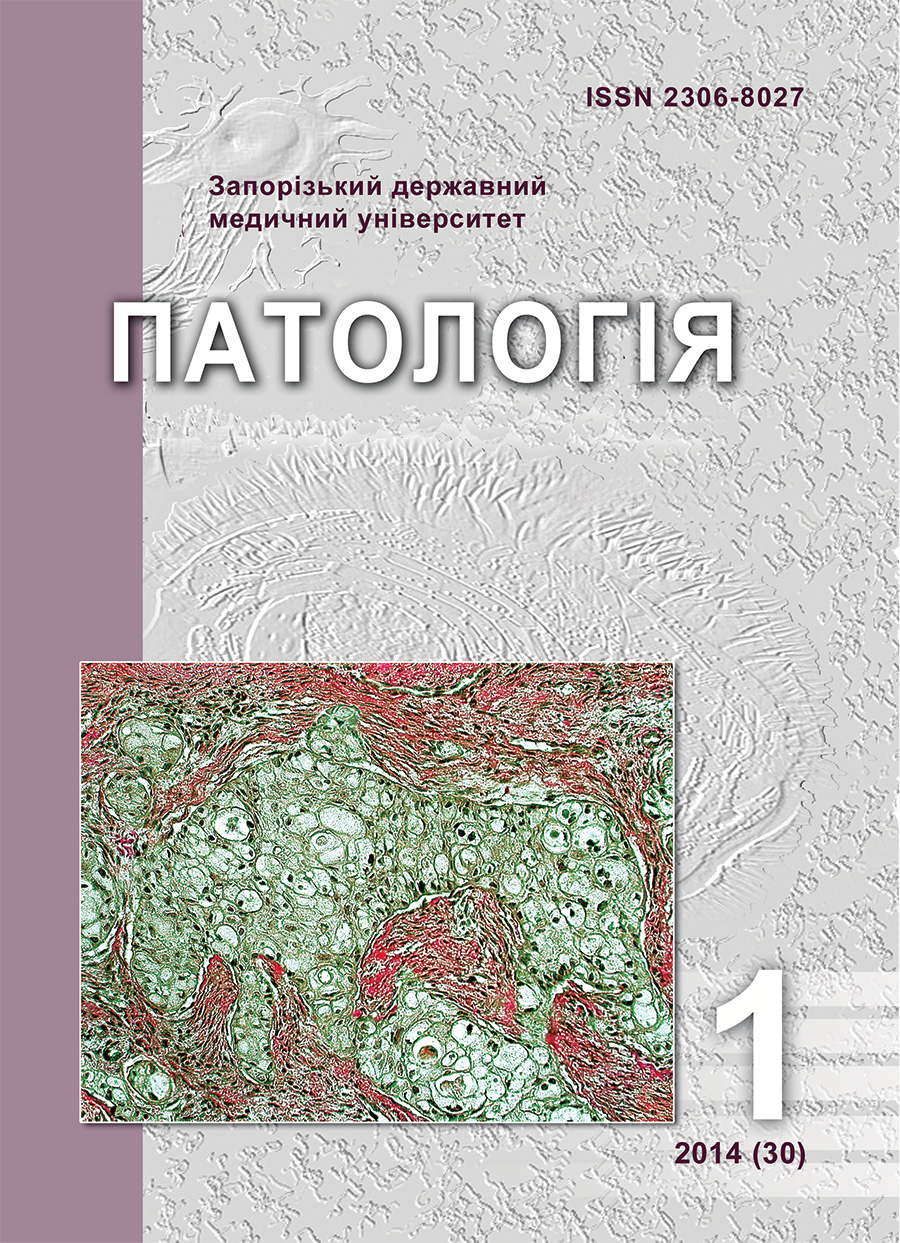Morphological characteristic of capillary malformations of head and neck
DOI:
https://doi.org/10.14739/2310-1237.2014.1.25251Keywords:
Сapillary malformations, Аrteriovenous malformationsAbstract
Introduction: the capillary malformations of head and neck are combined pathologies of the bloodstream which are characterized by a variety of structural changes of the bloodstream itself, as well as adjoining tissues. The efficiency of surgical treatment and absence of recurrences depend on the knowledge of peculiarities of the bloodstream structure in the capillary malformation zone and its periphery.
The aim of the research: to study the morphological characteristic of capillary malformations of head and neck.
Materials and methods: the operational material of simple and combined capillary malformations of head and neck of 30 patients (age 18–50 years old) was analyzed. The patients had been being treated since 2000 till 2013 at the department of the restorative microvascular surgery of the National Institute of Surgery and Transplantology named after A.A. Shalimov of NAMS of Ukraine.
Histological study was provided by means of fixing the material in 10% formalin solution with the phosphate buffer. The materials were processed using the standard histological method, the sections were stained by hematoxylin and eosin, azure-II-eosin, resorcin-fuchsin, PAS reaction with fermentation control was made.
The results: Simple and combined capillary malformations of head and neck were defined into 3 groups according to pathohistological investigation of the operation materials. Groups had significant structural differences: capillary, nodular capillary malformations, capillary arteriovenous malformations. The first group was formed by 12 cases (40,0%) of simple capillary malformations. Presence of a big number of enlarged capillaries of various diameter or venules of the middle size was typical for this type of malformations. The second group was formed by 3 patients (10,0%) with capillary malformations and nodular formations. The structure of the nodular formation resembles a simple capillary malformation. But some vessels, which are the parts of not formed or partially formed arteriovenous anastomosis, were found. The third group was formed by the cases of combined capillary-arteriovenous malformations with all typical signs of capillary malformations combined with arteriovenous micro shunts. The group was formed by 15 patients (50%). The presence of the arteriovenous micro shunts was a determinative criterion for the differential diagnosis.
The conclusion: It is rational to distinguish three types of the capillary malformations: simple capillary malformations, simple capillary malformations with the nodular formations and combined capillary-arteriovenous malformations. According to the results of the study the combined capillary-arteriovenous malformations cases are the most frequent. The cases of simple capillary malformations with the nodular formations are less frequent (2nd place). The surgical tactics for the patients must be determined by the type of the malformation (simple capillary or combined forms).
References
Mills, C. M, Lansigan, S. W, Hughes, J. & Anstey, A. V. (1997) Demographic study of port wine stain patients attending a laser clinic: Family history, prevalence of naevus anaemicus and result of prior treatment. Clin Exp Dermatol, 22, 166–168.
Breugem, C. C., Hennekam, R. C., Gemert, M. J., & M. A. M. Van Der Horst. (2005). Are Capillary Malformations Neurovenular or Purely Neural?. Plastic and Reconstructive Surgery, 115(2), 578–587.
Tark, K. C., Lew, D. H., & Lee, D. W. (2011). The Fate of Long-Standing Port-Wine Stain and Its Surgical Management. Plastic and Reconstructive Surgery, 127(2), 784–791.
Finley, J. L., Noe, J. M., Arndt, K. A., & Rosen, S. (1984). Port-wine Stains: Morphologic Variations and Developmental Lesions. Archives of Dermatology, 120(11), 1453–1455.
Selim, M. M., Kelly, K. M., Nelson, J. S., Wendelschafer-Crabb, G., Kennedy, W. R., & Zelickson, B. D. (2004). Confocal Microscopy Study of Nerves and Blood Vessels in Untreated and Treated Port Wine Stains: Preliminary Observations. Dermatologic Surgery, 30(6), 892–897.
Smoller, B. R., & Rosen, S. (1986). Port-wine Stains: A Disease of Altered Neural Modulation of Blood Vessels?. Archives of Dermatology, 122(2), 177–179.
Rydh, M, Malm, M, Jernbeck, J & Dalsgaard, CJ. (1991) Ectatic blood vessels in port-wine stains lack innervation: Possible role in pathogenesis. Plast Reconstr Surg. 87, 419–422.
Hennedige, A. A., Quaba, A. A., & Al-Nakib, K. (2008). Sturge-Weber Syndrome and Dermatomal Facial Port-Wine Stains: Incidence, Association with Glaucoma, and Pulsed Tunable Dye Laser Treatment Effectiveness. Plastic and Reconstructive Surgery, 121(4), 1173–1180.
Kulungowski, A. M., & Fishman, S. J. (2011). Management of Combined Vascular Malformations. Clinics in plastic surgery, 38(1), 107–120.
Maguiness, S. M., & Liang, M. G. (2011). Management of Capillary Malformations. Clinics in plastic surgery, 38(1), 65–73.
Mulliken, J B. & Glowacki, J. (1982) Hemangiomas and vascular malformations in infants and children: A classification based on endothelial characteristics. Plast Reconstr Surg., 69, 412–422.
Downloads
How to Cite
Issue
Section
License
Authors who publish with this journal agree to the following terms:
Authors retain copyright and grant the journal right of first publication with the work simultaneously licensed under a Creative Commons Attribution License that allows others to share the work with an acknowledgement of the work's authorship and initial publication in this journal.

Authors are able to enter into separate, additional contractual arrangements for the non-exclusive distribution of the journal's published version of the work (e.g., post it to an institutional repository or publish it in a book), with an acknowledgement of its initial publication in this journal.
Authors are permitted and encouraged to post their work online (e.g., in institutional repositories or on their website) prior to and during the submission process, as it can lead to productive exchanges, as well as earlier and greater citation of published work (SeeThe Effect of Open Access).

